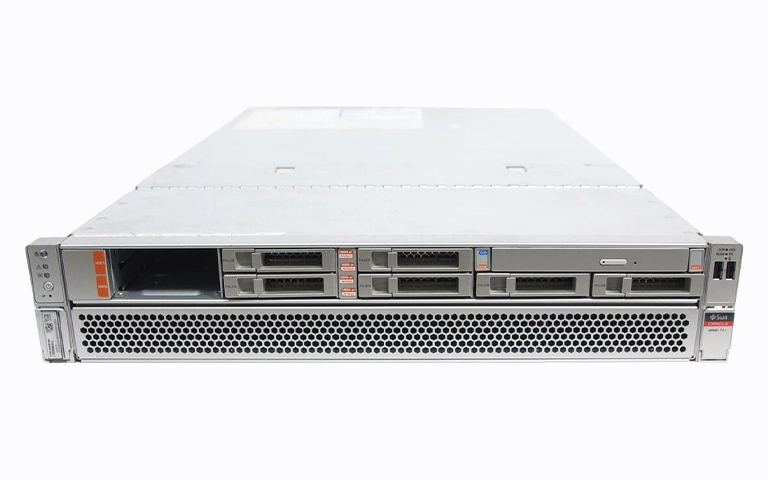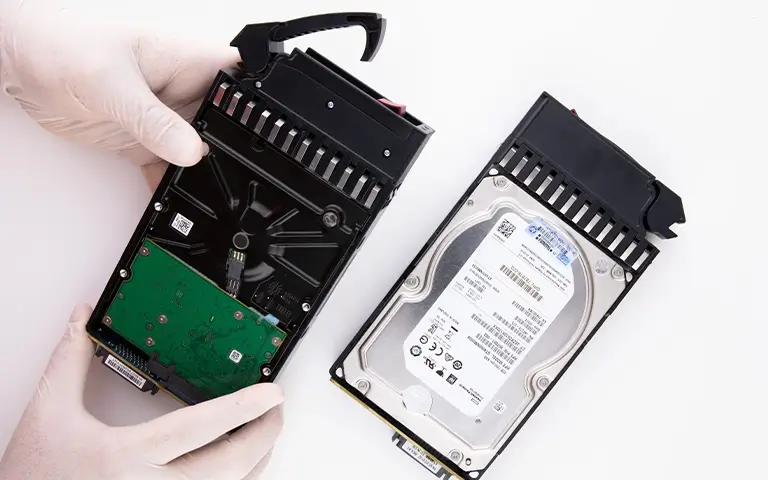When an organisation’s Oracle database stops responding without warning, the operational impact can be immediate and severe.
In this case, a financial institution faced exactly that scenario when its Oracle database became inaccessible following a power outage. The system relied on two enterprise grade hard drives configured in a RAID 0 array, storing critical financial indicators used for planning, reporting, and strategic decisions.
The sudden loss of power damaged both drives, leaving the entire database unreadable. Aware of the risk to business continuity, the client engaged RAID Recovery Services to provide specialist Oracle database recovery support.
Our engineers were tasked with restoring the company’s vital Oracle data as quickly and securely as possible.

Background: Database Setup And Failure Scenario
The Oracle Database Management System was hosted on two enterprise grade hard drives, each with a capacity of 72 GB, working together in a RAID 0 configuration.
This architecture was selected for its high read and write performance, enabling rapid access to the organisation’s financial analysis data.
However, RAID 0 provides no redundancy, so data loss on a single drive immediately affects the entire array and can put the whole Oracle database at risk.
During a sudden power outage, both drives became corrupted. The system failed to boot and the database could no longer be accessed. The client quickly stopped internal recovery attempts to avoid further damage and began looking for a specialist Oracle database recovery provider.
After reviewing several options, they chose RAID Recovery Services, recognised for managing complex RAID and enterprise grade HDD recovery projects.
Read more in our article about enterprise HDD recovery.
Emergency Evaluation and Initial Diagnostics
Given the importance of the lost data, the client selected our emergency Oracle database recovery service, designed for organisations that need rapid access to critical systems. As soon as the drives arrived at our lab, our engineers began diagnostics without delay.
The evaluation process involved examining each drive to determine the extent of both physical and logical damage.
One drive showed a normal electronic response, while the other displayed clear signs of mechanical failure. This early assessment enabled our team to pinpoint the affected components and plan the safest and most efficient recovery strategy.
By starting the process immediately, we reduced downtime and prevented further degradation of the storage media, helping to secure the best possible outcome for the client’s Oracle database recovery.

Cleanroom Repair: Fixing The Damaged HDD
Diagnostics confirmed that one of the drives had suffered a head crash, a common but serious fault that prevents normal read and write operations.
To carry out the repair safely, our engineers transferred the drive into an ISO certified cleanroom environment, where every step was completed under strict contamination control.
The repair process included:
Unsealing the drive: The damaged hard drive was carefully opened inside the cleanroom to prevent any particle contamination reaching the platters.
Ultrasonic cleaning: Internal components were cleaned using an ultrasonic system to remove microscopic debris created by the head crash.
Head assembly replacement: A compatible donor head stack was installed, precisely matched to the original specifications of the damaged drive.
Testing and calibration: The new heads were calibrated to read the platters correctly, ensuring stable conditions for imaging and Oracle database recovery.
Because the client had not attempted any DIY recovery or software based fixes, the platters remained free from scratches and additional physical damage, which significantly improved the chances of a successful outcome.
Find out more in our guide to RAID controller failure recovery.

Data Extraction And RAID 0 Reconstruction
After completing the physical repair, our engineers moved on to a precise data extraction and reconstruction process to restore the Oracle database from the damaged RAID 0 array.
The recovery involved several carefully controlled stages:
Each hard drive was cloned using specialist imaging equipment. This ensured every readable sector was copied without adding risk to the original media.
The cloned images were then analysed to confirm their consistency and to verify that no sectors had been skipped or corrupted during imaging.
Engineers identified the exact stripe size, order, and block structure of the RAID 0 configuration. Getting these parameters right was essential for an accurate rebuild of the array.
Using proprietary tools, a virtual RAID 0 configuration was created from the cloned images. This allowed the team to simulate the original storage layout and start extracting the Oracle database files safely.
Once the virtual RAID had been successfully rebuilt, Oracle database files were parsed, validated, and restored for final integrity checks.
This structured approach ensured a complete and reliable reconstruction of the RAID 0 array and laid the groundwork for a successful Oracle database recovery.
For further details, see our article on recovering a failed RAID 0 volume.

Results: Oracle Database Successfully Restored
Following the RAID 0 reconstruction, our engineers successfully restored the client’s Oracle database in full. All key data, including financial reports, analysis tables, and system records, was recovered without corruption or loss.
The restored files then underwent detailed verification to confirm their integrity and alignment with the original database structure.
Once validated, the data was securely copied to a new storage platform and returned to the client under strict confidentiality. The organisation was able to resume normal operations quickly, regaining access to its critical financial information without further disruption.
This case highlights how precise engineering and professional Oracle database recovery can fully restore RAID 0 systems after complex mechanical and logical failures.
Explore another Oracle database recovery case in our article.
Fast turnaround times for business-critical data
Conclusion And Professional Advice
Recovering data from an Oracle database running on RAID 0 requires highly specialised expertise, advanced tooling, and a strictly controlled environment. Even minor handling errors can result in irreversible data loss, which is why professional Oracle database recovery support is essential.
In this case, the client’s prompt response and decision to avoid self repair were critical factors in achieving a complete recovery.
Our engineers at RAID Recovery Services combined cleanroom repair, forensic imaging, and precise RAID reconstruction to restore every critical Oracle database file.
If your Oracle database or RAID platform becomes inaccessible after a power failure or drive malfunction, power the system down and contact a professional recovery lab immediately.
Our specialists are available 24/7 to help organisations restore lost data safely and efficiently.
Discover common reasons for RAID data loss in our article.

Trust the experts with proven results
Frequently Asked Questions
Can data from a failed Oracle Database RAID 0 system be recovered?
Yes, in many cases data from an Oracle database running on RAID 0 can be recovered. The final outcome depends on the level of physical and logical damage. Professional labs such as RAID Recovery Services use advanced imaging, analysis, and RAID reconstruction techniques to restore inaccessible Oracle data safely.
What causes RAID 0 array failures in Oracle Database systems?
RAID 0 failures are often linked to power outages, head crashes, firmware corruption, or controller faults. Because RAID 0 has no redundancy, damage to a single disk can affect the entire array and put the Oracle database at risk of complete data loss.
Why is cleanroom repair important during RAID data recovery?
Cleanroom facilities prevent dust and airborne particles from contaminating the drive during repair. This is critical when dealing with head crashes or exposed platters, helping to protect the media surface and maximise the chances of a successful RAID and Oracle database recovery.
Should I try to rebuild my RAID 0 array at home?
No. Attempting to rebuild a RAID 0 array without specialist tools and experience can overwrite critical sectors and permanently destroy existing data. It is safer to power the system down and consult an Oracle database recovery specialist to avoid escalating the damage.
How can I contact RAID Recovery Services for Oracle database recovery?
You can contact RAID Recovery Services via our Contact page or by calling our support team directly. Our engineers are available 24/7 to provide emergency advice, evaluation, and Oracle database recovery services for business critical systems.